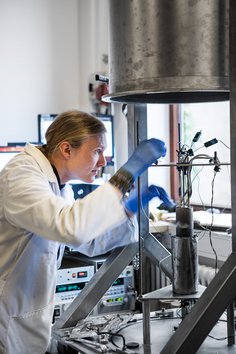Thermoelectric materials can interconvert thermal and electrical gradients. This means that they can transform heat into electricity (e.g. waste heat) or consume electricity to produce a heating/cooling effect.


A wide range of different synthesis techniques are employed to tailor thermoelectric materials for optimum efficiency. The key attribute is the so-called figure of merit, which combines the Seebeck-coefficient, thermal and electrical conductivities. Development of thermoelectric materials therefore hinges upon tailoring and accurate characterization of these three properties. One way is by producing functionally graded materials in which chemical compositions are designed to change continuously through a rod-shaped crystal. Another is synthesis of thin-films through magnetron sputtering, as the physical shape may dictate thermal conductivity. Likewise, a range of thermochemical or wet-chemical routes may be employed. Among others, these methods have been fruitfully employed by the Iversen group, and some examples of our work are given in the links below.
Of particular note is the Zn-Sb system, from which thermoelectric materials based on sustainable elements can be designed. Ongoing research between the Iversen group and the Danish company TEGnology ApS seeks to construct thermoelectric generators and sensors from such materials. Meanwhile, a range of other materials are researched in order to improve our understanding of thermoelectricity as a phenomenon and how it relates to atomic structure. This includes our groundbreaking work on the Mg-Sb system, where the Mg3Sb1.475Bi0.475Te0.05 composition determined by our group is now a hot topic in the thermoelectrics community.

In recent years, several alternatives to silicon solar cells have been commercialized, e.g. based on the semiconductor materials Cu(In,Ga)Se2 and CdTe. Unfortunately the Earth’s crust is almost devoid of indium and tellurium, and cadmium is highly toxic. New, sustainable alternatives are therefore called upon.
Seeking similar properties, attention is drawn to the same main group elements as tellurium – the elements known as chalcogenides. Here one finds, i.e., selenium and sulfur, which are much more abundant than tellurium. Sulfides in particular are very inexpensive materials which can be easily produced via hydro- or solvothermal synthesis even at low temperatures. They often possess band gaps around 1.4 eV, which is close to the optimal band gap for a solar cell material.
In my group we seek to better understand the semiconductor properties chalcogenide materials based on structural chemistry, and use that knowledge to develop novel chalcogenide materials for practical applications. The potential applications are not limited to solar cells but also include transistor devices or topological insulators. One material example is tin sulfide, SnS2, which has the useful band gap of 1.4 eV. It is synthesized as thin films of nanoparticles by means of a novel method based on inorganic surfactants which ensure good electrical properties. These are usually poor in thin films based on nanoparticles since organic, electrically insulating molecules are often used for surfactants in order to avoid particle aggregation and yield stable dispersions. If the organic linkers are removed by combustion, the films they leave behind become porous and contaminated with carbon, which also degrades the electrical properties. This problem may be avoided entirely by using inorganic linkers, e.g. (NH4)4Sn2S6. Upon decomposition (at 220oC) they form the gasses H2S and NH3 and more SnS2 which acts as an “electrical glue”. The result is films with good electrical properties, cheaply manufactured by spin-coating.